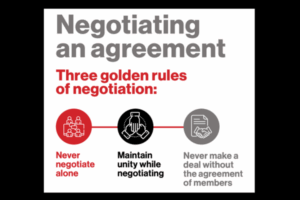An employer may dismiss employees based on operational requirements as defined in section 213 of the Labour Relations Act. Operational requirements range from economic and technological to structural.
The employer is responsible for proving that the operational requirement is genuine. A company cannot merely claim, for example, that it is not making money and therefore has to retrench workers. It has to at least show the latest financial statement.
Trade unions have the power to push employers to take the necessary steps to stimulate the economy to create jobs and prevent retrenchments. Even so, unions should have other practical strategies to save jobs.
Unions should also have strategies for minimising the impact for members if retrenchments seem unavoidable. For example, in South Africa the Covid-19 pandemic worsened the performance of the economy and many workers lost their jobs. The following guiding questions can help the union when thinking about strategies that can minimise the impact of layoffs and retrenchments of members.
Speak to the company
- Will the company place the workers on the Temporary Employee/Employer Relief Scheme (TERS), or is the company willing to continue to keep the contracts of employment with the workers, but place them on Unemployment Insurance Fund (UIF) support using the reduced working time provision?
- Can workers be re-deployed within the company and/or, if necessary, reskilled for new positions?
- Can the company reduce immediate retrenchments through gradual natural turnover of employees over time as they retire (natural attrition), or offer early retirement to volunteering employees?
- Can the company provide a fund to reskill the workers to help them seek new work, even if it cannot retain them?
- Can the company actively assist the workers to find secure alternative employment using their networks and connections?
- Can the company help the workers to start a new company and provide enterprise development support to it?
- Can the company pay higher severance packages to reduce the impact of retrenchment on the workers?
- Can agreements be made to revisit decisions pending changes in the business?
Speak to shareholders
- Can workers be redeployed into other companies in the group?
- Can the shareholders provide finance to reskill workers to help them find new work?
- Can the shareholders actively assist workers to find secure alternative employment using their networks and connections (even if not in the group)?
- Can shareholders provide shares to retrenched workers, over-and-above their severance pay, so that they have the opportunity for alternative income in the future?
Speak to other companies
- Do the employer association or business chamber know companies that could absorb the employees?
- Could competitors of the affected company absorb the employees?
- Could large customers or service providers to the affected company absorb the employees?
- Do the workers or union know other companies which are growing or more stable, which could absorb the employees?
- Do any large service providers of the union have opportunities to absorb the employees?
Skills training
- Explore whether the Labour Activation Programme (LAP) of the UIF has opportunities to absorb the workers into programmes for retraining to earn a stipend.
- Explore whether the Sector Education and Training Authority (SETA) have opportunities for the affected employees (such as stipend-paying learnerships), whether in the same industry or other industries.
- Challenge retrenchments. Is there an opportunity to refer the matter to the Commission for Conciliation, Mediation and Arbitration (CCMA) or even the Labour Court?
Takeaway: Negotiating retrenchments – A trade union guide to saving jobs (PDF)
You might like: Financial reporting – 15 key terms to get you started







